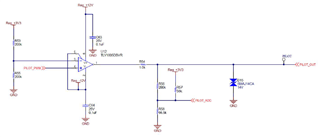hi team
my applicaiton is AC charging pile that refer to TIDA-010071 document . so using TLV1805 for Control Pilot Signal is our solution.
my question is
- why is the different output(PIN1) V of TLV1805 between simulation and measurment if pin3 and pin 4 is 0V . the output V of simulation is 12V ,but actual measurement is +12 to -12 4KHz wavefrom
-

- what is a correct status
- which a parameter of TLV1805 cause this problem such as Vos........
thanks

